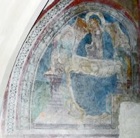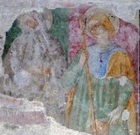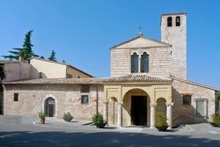
This was the site of two ancient buildings:
-
✴The “hospitale sanctae Mariae foris portam” was apparently documented in 1087 although this document, recorded by Ludovico Jacobili, no longer survives.
-
✴The church itself, which was first documented as a parish church (“plebem sancte Marie de Fulginia”) in 1138, when Pope Innocent II confirmed it as a possession of the Bishop Benedetto of Foligno. It was documented as "Sancte Marie extra portam vel in porta’" (Santa Maria outside the gate or at the gate) in 1207: the remains of this gate, Porta Santa Maria Vecchia, were found near the campanile in 1990.
Both of these documents were in the archives of the Abbazia di Sassovivo.
The church was administered by canons by 1239, and was thus of the same status as San Salvatore. It was documented as Santa Maria Infraportas from 1338, to reflect its position between Porta Santa Maria Vecchia and the later Porta Todi (at the far end of Via Santa Maria Infraportas).
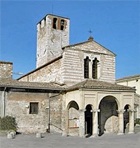
The construction of the main part of the church was carried out in a number of subsequent phases, as described below. It was comprehensively restored in 1855 and again in 1928, and underwent a more recent major restoration following the earthquake of 1997.
Exterior
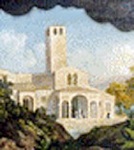
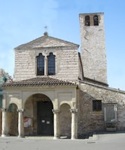
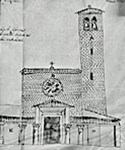
Detail of altarpiece (17th century) Present appearance Sketch (1752)
The detail of the altarpiece (17th century, described below) and the sketch (1752) reproduced here show that the facade, the portico and the campanile suffered major changes between these dates. These changes were subsequently reversed, probably during the restoration of 1855, by:
-
✴the addition of the present portico, reutilising the original columns;
-
✴the replacement of the rose window with the present bifore; and
-
✴the removal of the attic that had been added to the campanile.
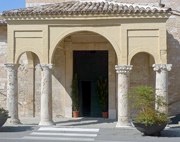

The four columns in the present portico probably came from an earlier church on the site. The sketch of 1752 shows similar columns on the facade of the church, although in this case, their capitals are all apparently similar to each other. The present capitals are of varied designs.
The pavement under the portico, like that inside the church, is now substantially below street-level.
Tabernacle (1480)
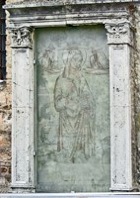
Right Transept
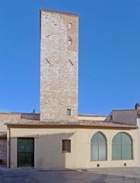
Interior
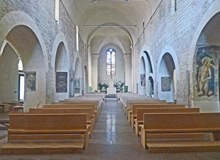
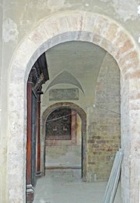
-
✴the entrance to the church, on the left;
-
✴the entrance to the chapel, which is immediately on your left as you enter.
A number of private chapels were built off the nave in the 15th century. The walls between them were demolished in the 16th century to create two lateral aisles. An adjacent building at the end of the left aisle was incorporated into the church as the Cappella della Sacra Famiglia in 1924 and now serves as the sacristy.
The frescoes on the walls of the church and on the three arches on each side of the nave were re-discovered during a restoration in 1928. They were mostly executed during the priorates of Marco di Paolo (1436-71) and Pietro di Domenico da Perugia (1471-84).
Left Wall of the Nave
Madonna and Child (15th century)
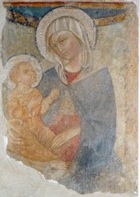
Second Pilaster on the Left
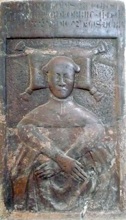
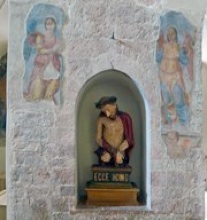
The pilaster contains:
-
✴the monument to Prior Giovanni d' Accursio (died 1380), is under the 2nd arch on the left (facing the entrance);
-
✴[marble tomb slab (1463) with the arms of Ser Petrus de Bicis]; and
-
✴a bust (16th century) in papier-mâché and gesso of the Ecce Homo (literally “here is the man”, the words of Pontius Pilate referring to the condemned Christ) in a niche facing the nave, with frescoes (16th century) of angels to the sides.
Frescoes on the 3rd Arch on the Left
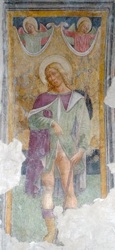
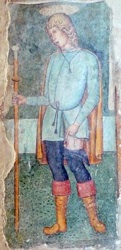
These two frescoes depict the standing St Roch pointing to a scar from the plague on his thigh:
-
✴The fresco (15th century) nearer the entrance is attributed to Pierantonio Mezzastris.
-
✴The second fresco (early 16th century) is attributed to his son, Bernardino Mezzastris.
Presbytery
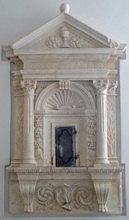
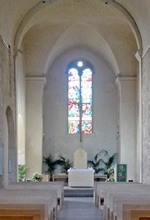

The presbytery was rebuilt during the recent restoration. Its stained glass was installed at that time. It also contains:
-
✴a gilded wooden Crucifix (16th century) above the new high altar;
-
✴a marble tabernacle (16th century) on the left wall; and
-
✴statutes (date?) of SS Peter and Paul in niches on the side walls.
Right Wall of the Nave
Third Arch on the Right
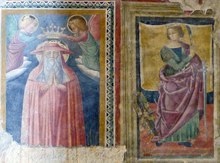
The frescoes under this arch, on the wall to the right presbytery depict:
-
✴the upper part of a figure (15th century) of the standing St Jerome, who is dressed as a cardinal and crowned by two angels, attributed to Pierantonio Mezzastris; and
-
✴a figure (16th century) of the standing St Catherine of Alexandria.
Third Pilaster on the Right
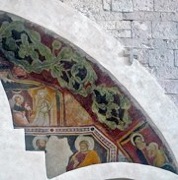
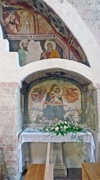
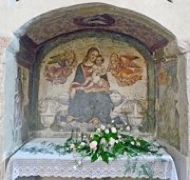
The altar here is in a niche facing the nave. The associated frescoes (15th century) depict:
-
✴above the altar:
-
•the Madonna and Child with angels; and
-
•[frescoes above and the the sides]: and
-
✴in the niche above:
-
•the Annunciation;
-
•SS Peter and Paul; and
-
•a fragment of the Madonna del Latte, under the arch.
Second Arch on the Right
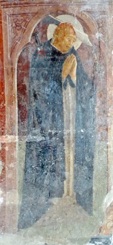
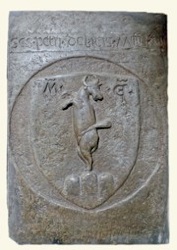
This arch contains:
-
✴a fresco (15th century) of St Peter Martyr (facing the entrance), which is attributed to Nicolò di Liberatore, l’ Alunno; and
-
✴[coat of arms?].
First Arch on the Right
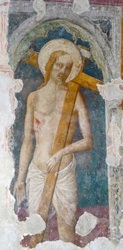
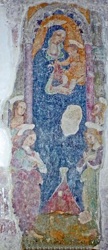
The frescoes under this arch depict:
-
✴Christ carrying the cross (15th century), attributed to Nicolò di Liberatore, l’ Alunno (facing the entrance); and
-
✴the Madonna and Child with angels (16th century).
Left Aisle
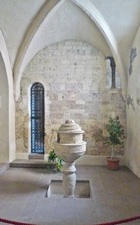
Madonna and Child with St John the Evangelist (ca. 1500)
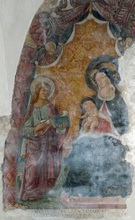

This fresco in the 2nd bay of the left wall is signed by Ugolino di Gisberto and partially dated 15.. in the inscription. It was damaged when the window to the right was inserted, at which time another figure to the right was lost.
Madonna del Salute (date?)
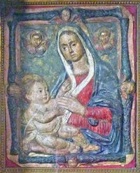
Cappella della Sacra Famiglia

Right Aisle
Frescoes of the Crucifixion (15th and 16th centuries)
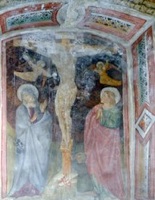
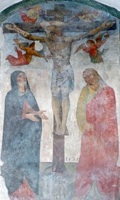
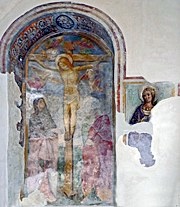
3rd bay 2nd bay 1st bay
The frescoes in the first three bays on the right wall all depict the Crucifixion with the Virgin and St John the Evangelist:
-
✴the fresco in the 3rd bay, in which the donor kneels at the foot of the cross, has been heavily repainted;
-
✴the fresco (1525 )in the 2nd bay, which is dated by inscription, is attributed Bernardino Mezzastris; and
-
✴the fresco (15th century) in the 1st bay is attributed to Pierantonio Mezzastris. The fragment of a figure of a female saint to the right of it has the same attribution.
Pietà (15th century)
Counter-facade
SS Onuphrius (Onofrio) and Roch (15th century)
Sacristy
The present sacristy is made up of two distinct spaces:
-
✴the right transept; and
-
✴the space between this transept and the campanile.
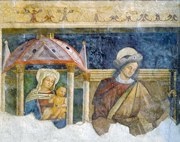
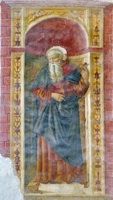
There are two frescoes in the first of these spaces:
-
✴the Madonna and Child with St Roch (15th century); and
-
✴St Antony Abbot (16th century)
[Portrait of Prior Crispoldo Mattoli, died 1688.]
Art from the Church
Madonna and Child with Blessed Andrea Caccioli (ca. 1630)
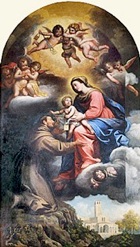
The altarpiece has been extended to the right at some point. In addition two scapulars have been added:
-
✴the baby Jesus hands one to the Blessed Andrew; and
-
✴the angel on the left in the uppermost group holds the other.
This suggests that the figure of the Blessed Andrew was read as the Carmelite St Simon Stock at some point in the history of the altarpiece.
The altarpiece was in the presbytery of the church until the recent restoration. [Where is it now?]
Read more:
P. Guerrini and F. Latini, “Foligno: Dal Municipium Romano alla Civitas Medievale: Archeologia e Storia di una Città Umbra”, (2012) Spoleto
See this website dedicated to the church.
Return to the page on Monuments of Foligno.
Return to to Walk II.


